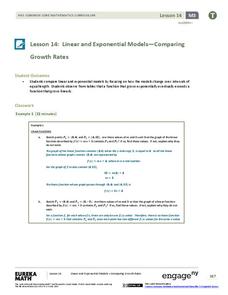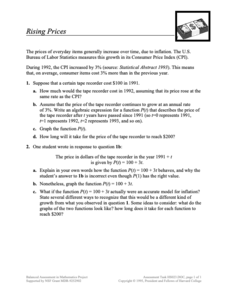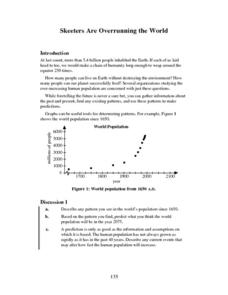Curated OER
NUMB3RS Activity: Chains and Pyramids
Watch an episode of the TV show, NUMB3RS and then explore the mathematics of chain letters and pyramid schemes, both of which involve geometric progressions and exponential growth. They discuss why both are dangerous and illegal.
Curated OER
Exponential Growth and Decay
In this Algebra II worksheet, 11th graders solve verbal problems that involve exponential growth or decay. The two page worksheet contains a combination of seven multiple choice and free response questions. Answers are...
Key Curriculum Press
Applications of Exponential Functions
Exponential functions are the name of the game. Young mathematicians can work through each of the eight worksheets by evaluating functions, applying logarithms, completing logarithmic functions, and building inverse functions. This...
EngageNY
Comparing Linear and Exponential Models Again
Making connections between a function, table, graph, and context is an essential skill in mathematics. Focused on comparing linear and exponential relationships in all these aspects, this resource equips pupils to recognize and interpret...
Curated OER
Exponential Functions
Analyze functions by their shape and equation and identify decay and growth based on the equation given. Learners graph their exponential functions and differentiate it using the logarithmic versus the exponential function.
Curated OER
Algebra 1 Unit 8 Review
In this math worksheet, students practice the techniques associated with algebra 1. This 5-page worksheet has many different types of problems for the students to solve.
Curated OER
Exponential Growth
Students study exponential functions. In this exponential growth instructional activity, students conduct a simulation in which a population grows at random but predictable rate. Students compare and contrast linear and exponential...
Curated OER
Exponential Functions f(x) = abx
Students define exponential functions and graph the equation. In this algebra lesson plan, students discuss exponential growth and decay as they graph their functions. They differentiate between the base of growth and decay.
Curated OER
A Penny Saved is a Penny Earned
Students explore the concept of exponential growth. In this exponential growth lesson plan, students manipulate power models with base 2. Students discuss what would happen if you doubled a penny over the course of 20...
Mathematics Vision Project
Module 4: Linear and Exponential Functions
Sequences and series are traditionally thought of as topics for the pre-calculus or calculus class, when learners are figuring out how to develop limits. But this unit uses patterns and slopes of linear functions in unique ways...
Curated OER
Graphing at all Levels: It's a Beautiful Thing!
Mixing math and art is done in this lesson by applying graphing knowledge to create a unique piece of art. This lesson varies acording to the graphing knowledge of the artist. First, learners identify and review various types of graphing...
EngageNY
Modeling with Exponential Functions
These aren't models made of clay. Young mathematicians model given population data using exponential functions. They consider different models and choose the best one.
EngageNY
Linear and Exponential Models—Comparing Growth Rates
Does a linear or exponential model fit the data better? Guide your class through an exploration to answer this question. Pupils create an exponential and linear model for a data set and draw conclusions, based on predictions and the...
EngageNY
Solving Exponential Equations
Use the resource to teach methods for solving exponential equations. Scholars solve exponential equations using logarithms in the twenty-fifth installment of a 35-part module. Equations of the form ab^(ct) = d and f(x) = g(x) are...
Mathematics Vision Project
Quadratic Functions
Inquiry-based learning and investigations form the basis of a deep understanding of quadratic functions in a very thorough unit plan. Learners develop recursive and closed methods for representing real-life situations,...
Curated OER
Discovering Growth Patterns
Students explain the differences between linear (arithmetic) and exponential (geometric) growth. They use worksheets imbedded in this lesson to help them make predicitions and graph data points.
Curated OER
Exponential Functions
Your algebra learners analyze and interpret the general form and the graph of two functions. The increase of the function due to the multiplicative factor is emphasized.
Concord Consortium
Rising Prices
What will that cost in the future? The scenario provides pupils with a growth as a Consumer Price Index. Learners create functions for a given item to determine future prices and graph them. Class members then compare their functions to...
Curated OER
Applications of Exponential Functions
In this algebra worksheet, students solve word problems involving money. They calculate the interest earned over a period of time given the formula. There are 28 questions.
Curated OER
Credit Cards and Compound Interests-Exponential Growth
Eleventh graders investigate the way credit cards work when collecting interest. For this algebra lesson, 11th graders investigate the growth of interest exponentially when using a credit card. They calculate what the cheapest rate is to...
Annenberg Foundation
Skeeters Are Overrunning the World
Skeeters are used to model linear and exponential population growth in a wonderfully organized lesson plan including teachers' and students' notes, an assignment, graphs, tables, and equations. Filled with constant deep-reaching...
Curated OER
Exploring the Exponential Function
Learners collect and analyze data regarding exponential functions of the form y = abx. Students explore the affects of changing parameters on the graph of the function.
Curated OER
Comparing Linear and Exponential Functions
Teach your class how to differentiate between linear and exponential functions. They use exponential properties to solve problems, graph them using the TI-Navigator, and make comparisons.
Curated OER
Equal Factors Over Equal Intervals
Exponential functions and their growth rates are explored concretely using tables in a collaborative task. Then the successive quotient is explored algebraically.























